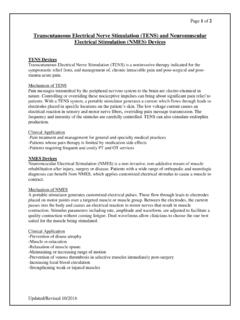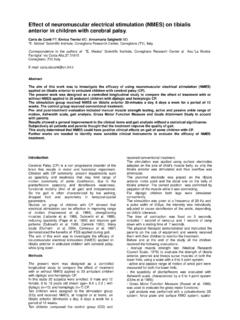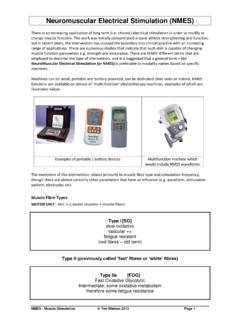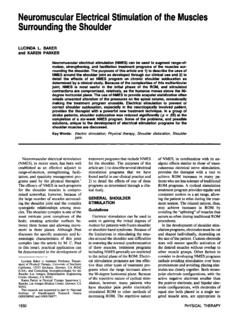Transcription of Introduction and Update on the Objectives Use of ...
1 3/18/20131 Introduction and Update on the Use of neuromuscular electrical stimulation for neurologic Populations Barbara M. Doucet, OTR, PhDLOTA Spring ConferenceMetairie, LAMarch 2013 Objectives By the end of the session, participants will be able to: 1. Describe how neuromuscular electrical stimulation (NMES) is used in the practice of occupational therapy and articulate the theoretical and regulatory issues associated with the use of NMES; 2. Explain the essential elements of electrotherapy and define the individual NMES parameters used in treatment regimens; 3. Summarize the effects of electrotherapy on muscle tissue and demonstrate an understanding of the conditions that could benefit from NMES application; 4. Objectively evaluate the current scientific evidence supporting the use of NMES in occupational therapy practice; 5. Administer an NMES program to a partner, evaluate the response, and reciprocate by having the program applied to themselves;Definition: PAMs Physical Agent Modalities (PAMs) are those procedures and interventions that are systematically applied to modify specific client factors when neurological, musculoskeletal, or skin conditions are present that may be limiting occupational performance.
2 Bracciano, 2008;Definition: PAMs PAMs use various forms of energy to modulate pain, modify tissue healing, increase tissue extensibility, modify skin and scar tissue, and decrease edema/inflammation. PAMs are used in preparation for or concurrently withpurposeful and occupation-based , 2008 Categories of PAMs Superficial thermal agents Deep thermal agents Electrotherapeutic agents Mechanical devicesElectrotherapeutic Agent Definitions NMES: neuromuscular electrical stimulation FES: Functional electrical stimulation ES: electrical stimulation TENS: Transcutaneous electrical Nerve stimulation TMS: Transcranial Magnetic Stimulation3/18/20132 NMES What it isn t Superficial Topical Non-invasive What it is INVASIVE!!! Subcutaneous Altering processPhilosophical Issues -History PAM use said to be inconsistent with the basic philosophy of OT (the use of purposeful activity for health/healing) Incorporating into profession will open it up to criticism, public confusion, political issues, and redundancy with PT Not intrinsic or unique to our profession and not occupational in natureMcGuire, 1991; West & Weimer.
3 1991;ACOTE Standards: OT OT education to include Explain the use of superficialthermal and mechanical modalities as a preparatory measure to improve OP, including foundational knowledge, underlying principles, indications, contraindications, & precautions. Demonstrate safe and effective application ofsame. Explain the use ofdeepthermal and electrotherapeutic modalities as a preparatory measure to improve OP, including indications, contraindications & s Position Paper PAMs are categorized as preparatory methods Preparatory methods support & promote the acquisition of performance skills necessary to enable an individual to resume or assume habits, routines and roles for engagement in occupation. (AOTA, 2008)Current AOTA Status on PAMs ..PAMs may be applied only by OTs and OTAs who have documented evidence of possessing the theoretical background and technical skills for safe and competent integration of the modality into an OT intervention planAOTA, 2012 Current Status The foundational knowledge necessary for proper use of these modalities requires appropriate, documented professional education, which includes continuing education courses, institutes at conferences, and accredited higher education courses or , 2012;3/18/20133OT and OTA Application When an OT delegates the use of a PAM to an OTA, both must comply with appropriate supervision and state regulatory requirements and ensure that preparation, application, and documentation are based on service competency and institutional rules.
4 Only OTs with service competency in this area may supervise the use of PAMs by OTAs. Occupational therapy assistants may gain competency only in those modalities allowed by state and laws and regulations. What PAMs PAMs are Should be used before or concurrently with purposeful activity or during occupational engagement PAMs are not an entry-level skill Not a long-term interventionIMPORTANT!!!!! The exclusive use of PAMs as a therapeutic intervention without application to occupational performance is NOT considered occupational therapy. Discussion Do you currently use PAMs in your practice? With which diagnoses? Do you feel the use of PAMs in practice is in opposition to the philosophical and theoretical basis of OT?Current Trends Greater use and acceptance of PAMs in OT practice Evidence-based practice Some states have drafted licensing guidelines to ensure competency and safe use of PAMsCertification in PAMs Some states have moved to specific licensing/certification or documented evidence of proficiency in PAMs before allowing application AOTA approved certification course Tennessee Oregon Nebraska Minnesota Georgia Massachusetts California Ohio Maryland Montana3/18/20134 Continuing Education AOTA directive Important to directly experience NMES before applying to patient Knowledge base needed for correct application Continued use and experience with different methods leads to expertiseDiscussion What specific knowledge do you hope to take home with you today from this workshop?
5 Principles of ElectrotherapyLong History of Electrotherapy Late 1700s: Luigi Galvani Used in therapeutic applications for over 40 yearsBracciano, 2008 Definitions NMES: use of pulsed alternating current (AC) to stimulate a motor response by depolarizing intact peripheral nerves Used to reduce muscle spasm, spasticity, increase muscle strength, facilitate muscle re-education, reduce edema, tissue/wound healingBracciano, 2008 Definitions HVGS: High-voltage galvanic stimulation ; used for tissue repair and pain control Stimulator uses an interrupted monophasic twin-peak waveform Output > 150 volts Iontophoresis: Induction of topically applied pharmaceuticals into bodily tissue by application of a low-voltage direct galvanic electrical current. Used for inflammatory conditions such as tendonitis bursitis, myositis and scar tissue modificationBracciano, 20083/18/20135 Nerve & Muscle: Excitable Tissue Can maintain an electrical potential across cell membrane Can respond with alteration in potential APs occur when a stimulus excites the nerve cell causing membrane depolarization Can be caused by thermal, mechanical, chemical, or electrical stimuliBracciano, 2008+ + + + + + + + + + + + + + + + + + + + + + + + + + + +Nerve Fiber Resting StateNa-- - - - - - - - - - - - -- - - - - - - - - - - - - -- - - - - - - -K -70mv- - - - - - - - - - - - -- - - - - - - - - - - - - -- - - - - - - --+ + + + + + + + + + + + + + + + + + + + + + + + + + + +Adapted from Baker et al.
6 , 2000+ + + + + + + + + +Generation of Action PotentialNa-- - - - - - - - - - -+ + + + + + + + + + + + + + + + + + +K 40mv- - - - - - - - - - - -+ + + + + + + + + + + + + + + + + ++ + + + + + + + + + - - - - - - - - - - -- - - - - - - - - --Stimulus- - - - - - - - - - - -- - - - - - - - - - -RP -70AP 40mvAdapted from Baker et al., 2000 Basic electrical Principles electrical Current: flow or movement of electrons or charged particles from one point to another with a purpose to re-establish balance between negative and positive charges Electricity: energy that produces magnetic, chemical, mechanical, and thermal effects Current always takes a path of least resistance Characteristic flow is from an area of high concentration (cathode) to an area with less concentration (anode)Bracciano, 20081010101010 Surface TissueInterstitial Tissue+101010101055555 Surface TissueInterstitial Tissue-+-55555 The Path of Least ResistanceThe Path of Least ResistanceAdapted from Baker et al.
7 , 2000 electrical Current Propagation Current is best carried through the water in tissues Thus, structures with high water content will have lower impedance and better electrical conductance Rate of propagation dependent on diameter of nerve fiber and degree of myelination Larger diameter fibers = lower resistance to currentBracciano, 20083/18/20136 Impedance & Resistance Impedance: the opposition to the flow of electrons in tissue; Characterized as the resistance to the current Resistance: the property of a substance that opposes or resists the flow of current The greater the impedance or resistance in an electrical circuit, the lower the rate of flowBracciano, 2008 Tissue ImpedanceTissue Water ContentElectrical ImpedanceElectrical ConductanceBoneSkinFatMuscleNerveBloodAd apted from Bracciano, 2008 electrical Currents in the Clinical Setting Direct current (DC) Unidirectional flow of either (+) to ( ) or ( ) to (+) electrons Galvanic Can cause chemical reactions in body or burns to skin Used often for scar modification or medication administration Can be used to directly stimulate denervated muscleBracciano, 2008 electrical Currents in the Clinical Setting Alternating current (AC) Continuous change in direction of electron flow Typically supplies electricity for household items Bidirectional flow that can be interrupted or not interrupted Absence of net charge (no concentration of positive or negative at one pole)
8 Also described as biphasic waveform or bidirectional current Minimal damage due to lack of accumulation of (+) or (-) electronsBracciano, 2008 electrical Currents in the Clinical Setting Pulsed Current Most stimulators deliver pulsed current using one of three pulsed waveforms: 1/ Monophasic One phase to each pulse Unidirectional flow of ions Direct stimulation of denervated muscle; transmission of medsBracciano, 2008 Pulsed Current 2/Biphasic Consists of two opposing electrical phases in a single pulse (positive and negative) Can have symmetrical, asymmetrical, balanced or unbalanced phases Asymmetry or imbalance creates a build up of electrons Symmetrical biphasic more comfortable for NMES patient use Asymmetrical sometimes used for smaller muscles under negative electrode Symmetrical better for large muscles or for combined movement Bracciano, 20083/18/20137 Pulsed Current 3/Polyphasic Burst of three or more pulses Series of pulses delivered as a single charge (perception is of a single pulse) Uses medium frequencies Used in Interferential: pain relief, increase blood flow, muscle stimulation Russian stimulation : increases muscle mass and strength gains.
9 High frequency,1:5 duty cycleBracciano, 2008 Direct CurrentDirect CurrentPulsatile Pulsatile CurrentCurrentInterruptedInterruptedDire ct CurrentDirect CurrentAdapted from Bracciano, 2008 Alternating Alternating CurrentCurrentDiscussion Have you ever felt electrical stimulation ? If not, what do you anticipate it will feel like? How do you think your patients will respond with the first use?Sensory PerceptionPAINPAINM otorMotorSensorySensoryINTENSITY OF STIMULATIONType A sensory fibers,Group A, II beta, III; C fibers Group IVType A motor fibersType A motor, A & C sensoryParameters of electrical stimulation Amplitude Duration Rate/Frequency Pulse Train Pulse Pattern Duty Cycle Ramp TimeBracciano, 2008 Amplitude Amount of current/voltage delivered during a single phase of a pulse Also known as Intensityor Pulse Intensity Measured in mA or A Begin at 0 for best results and increase in gradual increments ( mA)Bracciano, 20083/18/20138 Duration Pulse duration is the amount of time that elapses between the onset of one phase in a pulse to the end-point of the second phase in the same pulse Typically measured in s or ms As phase duration increases, depth of penetration will increase As phase duration increases, more discomfort is present, greater chemical changes can occur, more impedance presentBracciano, 2008 Rate/Frequency Number of pulse cycles being delivered to body tissues Expressed as pulses per second(pps) Frequency of current being delivered expressed as Hertz (Hz)
10 , Slower rate (1-5 pps) acts as a pumping mechanism; Faster rate will recruit more muscle fibersBracciano, 2008 FrequencyHigher vs. Lower? Rightward shift of force-frequency relationship after fatigue Thomas et al., 1991 Fuglevandet al., 1999 Low Frequency Fatigue (LFF) Edwards, 1977 LFF possibly more prevalent in older adults Allman& Rice, 2002 Paralyzed muscle generally weak and fatigable; higher frequencies needed Griffin et al., 2002 Thomas et al., 2003 Force-Frequency RelationshipFuglevand et al., 1999 Pulse Train Intermittent vs. Continuous20 Hz Continuous20 Hz Intermittentl l l l l l l l l l l l l l l l l l l ll l l l l l 05001000 Time (ms)Duty Cycle Ratio of time on to time off; expressed as ratio (1:3, 1:5, etc.) Can be expressed as on/off time Percentage (total on time/total on+off time) X100 Important in determining amount of fatigue Shorter off-time = greater fatigue Typically used: 1:3 Bracciano, 20083/18/20139 Ramp Time Amount of change in pulse intensity or duration from zero to a point of maximum (ramp up) Amount of change in pulse intensity or duration from maximum back down (ramp down) Amount of current can be adjusted to gradually increase over a time period (1-8s; typical: 2s) Used for patient comfort during initial stimulation Reproduces a normal contraction sensation , longer ramp time for spastic tissue Ramp time is calculated as part of total on timeDepth of Penetration High-voltage unit: up to 500 V; more current delivered Low-voltage unit: 0-150 V.











